Calico Goldfish are not smart as other pets like cats and dogs. But they come to the surface when you come near to the tank. They know you look after them and also, they love you back and reduce your stress.
In this article, I’ll answer all your questions regarding Calico Goldfish. Hopefully, by the end of the article, you’ll feel confident adding them to your collocation.
The appearance of Calico Goldfish
Jump To
- 1 The appearance of Calico Goldfish
- 2 Origin of the Calico Goldfish
- 3 Size of the Calico Goldfish
- 4 Calico Goldfish’s Life span
- 5 Types of Calico goldfish
- 6 Tank preparation for your Calico Goldfish
- 7 Water quality that suitable for Calico Goldfish
- 8 Cleaning and maintainig your Calico Goldfish tank
- 9 Should I Completely clean out the Calico Goldfish tank?
- 10 How to feed the Calico Goldfish
- 11 Tank mates of Calico Goldfish
- 12 Common Calico Goldfish diseases
- 13 How to breed Calico Goldfish
- 14 Difference between albino telescope fish and Calico Goldfish
- 15 Difference between black moors fish and Calico Goldfish
- 16 Related questions
Calico is a type of coloration that is specific to the calico goldfish and this fish has streamlined bodies. Also, calico has an elongated and flat body. It has a wide head but it is short.
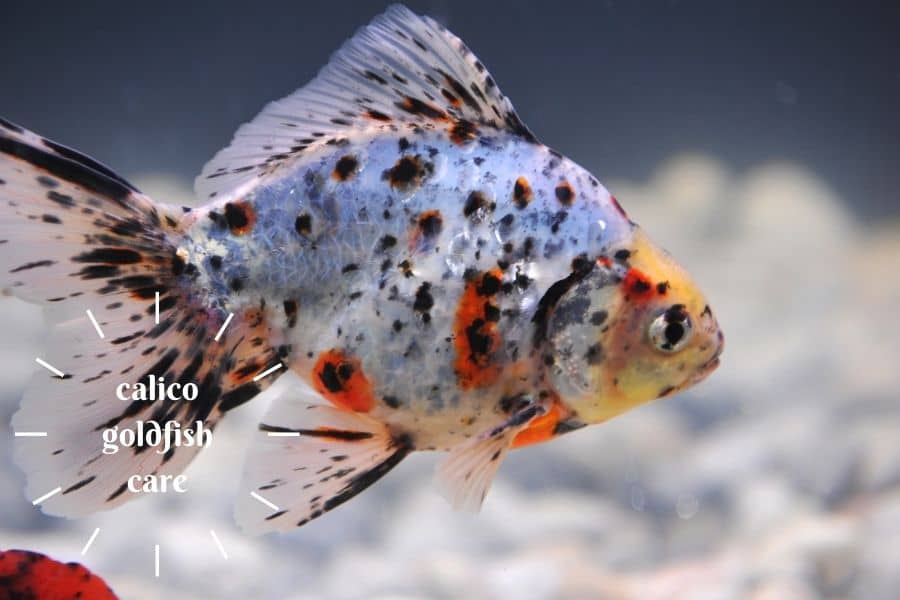
The fins of calico goldfish stand fully erect and the edge of the dorsal fin is slightly concave. Calico coloration varies with every individual fish, but you can easily identify the calico coloration. Generally, calico fish have patches that spread all over their body including their fins.
These color patches take on white, red, yellow, and black to varying degrees and these patches are varying in size.
Further, there are calico fish with lighter splashes of blue and grey. Important thing is to note that true calico goldfish were often confined to the shubunkin varieties. Blue color calico is the most expensive species on the market.
Origin of the Calico Goldfish
Shubunkins are calico goldfish and they have Japanese origin. Shubunkins are single-tailed beautiful fish with mind-blowing coloration namely calico. Calico goldfish create by crossing Calico telescope eye goldfish (Demekins), Comet goldfish, and the Common goldfish around the 1900s. Yoshigoro Akiyama is the creator of this wonderful production.
You can not see calico goldfish in wild nature. Generally, goldfish were made by crossing several species of carps namely Prussian carp, Silver Prussian carp, Gibel carp lived in wild. You can find wild carp in Central Asia.
Size of the Calico Goldfish
Calico goldfish have the ability to reach different sizes. Because that this fish species had bred by crossing various goldfish varieties.
These are telescope eye goldfish, ryukins, fantails. The largest breed of goldfish is the Oranda goldfish and it has the ability to grow up to a foot (30.5cm) in length. The oranda goldfish also comes in calico and it is able to reach the full size that above mentioned.
In general, when calico goldfish lives in an average 15-gallon tank and if the tank is not crowded, it can grow up to about 5 inches (12.7 cm). If you have a bigger and uncrowded tank, it allows calico to grow up to about 6 inches (15cm).
Calico Goldfish’s Life span
Normally goldfish can easily exceed 10 years of age in tank or pond conditions. The current maximum age record is 43 years. The average lifespan of calico goldfish is about 10-15 years. But if you look after your calico well, it has the ability to live more than 15 years.
However, when considering the life span of calico goldfish, it mainly depends on the breed.
The reason is, that some breeds are bred to exhibit detrimental characteristics and these characteristics cause to hinder their ability to thrive. An example is a fancy goldfish that has exaggerated head and fins growth.
Because of these detrimental characteristics, fish can not swim properly and are easily exhausted from swimming. It badly affects the quality of the life of fish including their feeding habits. Because of this, the lifespan of goldfish including calico goldfish tends to short.
Types of Calico goldfish
Ryukin Calico goldfish
Ryukin goldfish has a short deep body with beautiful calico coloration. These fish have pointed heads. Also, they have a pronounced hump on the back behind the head.
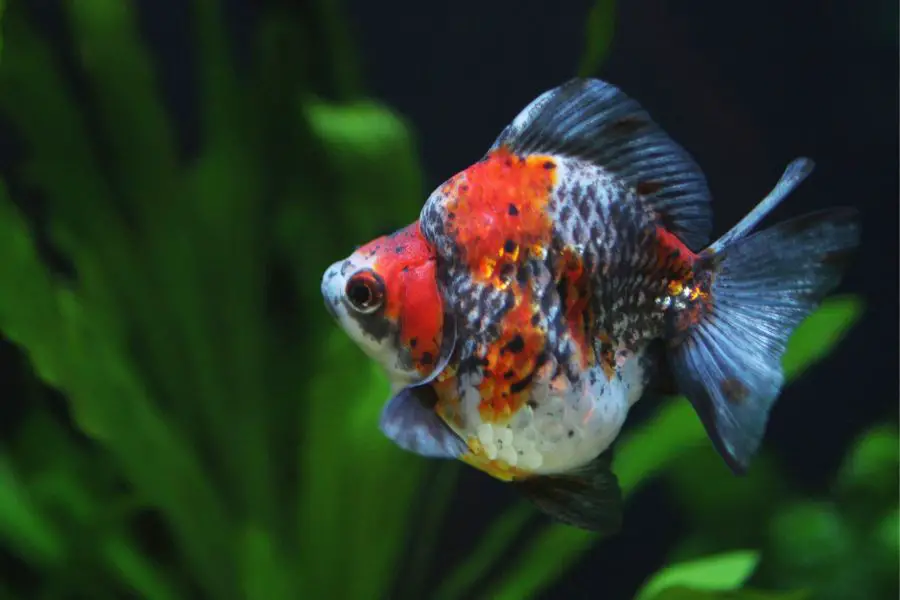
Telescope eye goldfish
This goldfish has enlarged projecting eyes. This is the only thing that these fish differ from ryukin and fantail. Telescope eye goldfish has a deep body with long flowing fins. This type of goldfish also comes in calico coloration.
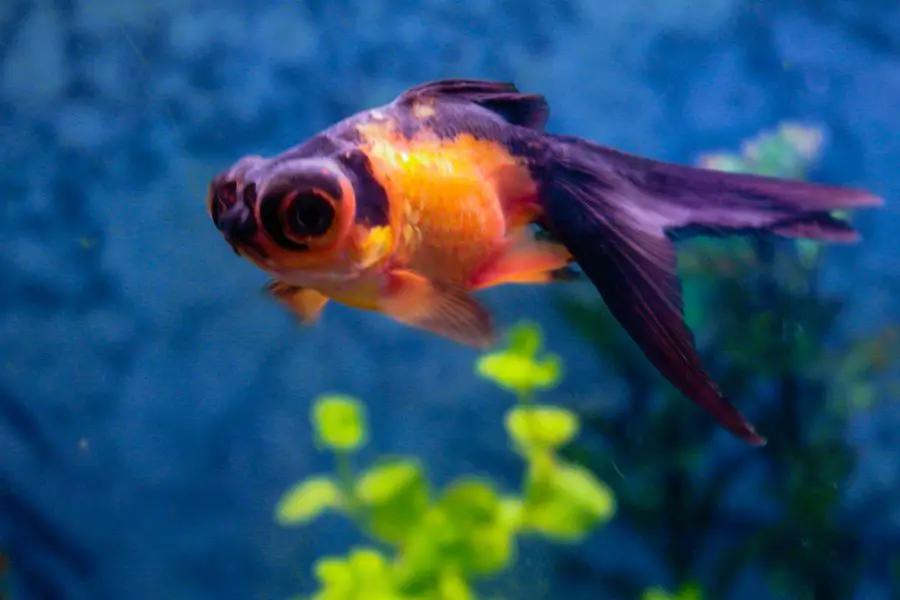
The London Shubunkin goldfish
This type of calico fish is similar to the common goldfish types. The London Shubunkin goldfish/ calico goldfish has a short deep body and it is slender. You can see more rounded fins in this calico fish. The London goldfish come in a variety of colors, but still with calico patterns.
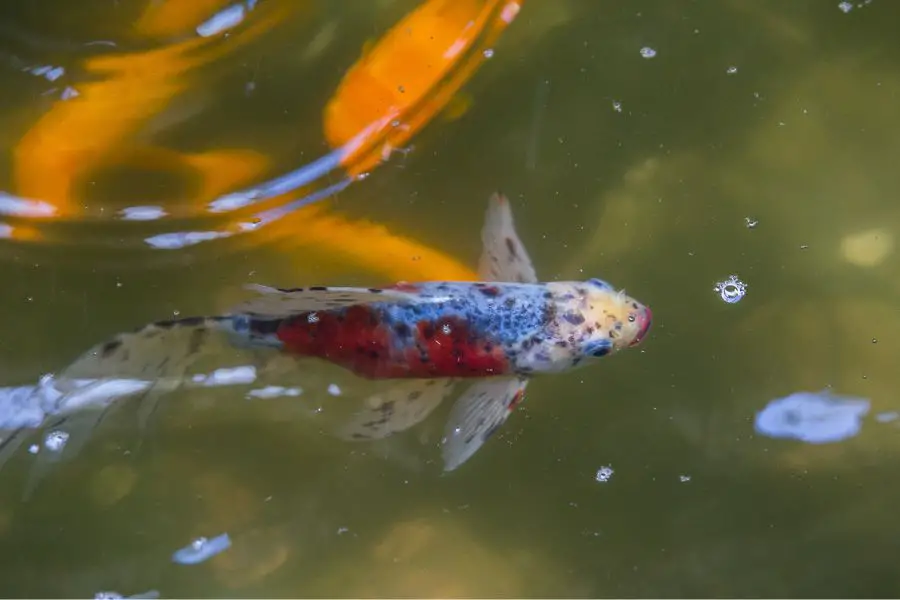
The Bristol Shubunkin goldfish
The body of this type of calico goldfish is similar to the Comet goldfish. It is more slender. Bristol Shubunkin goldfish/ calico goldfish has distinctive, wide, forked, and huge tail fin with well-rounded lobes. These fins can be deterred from the ability to swim.
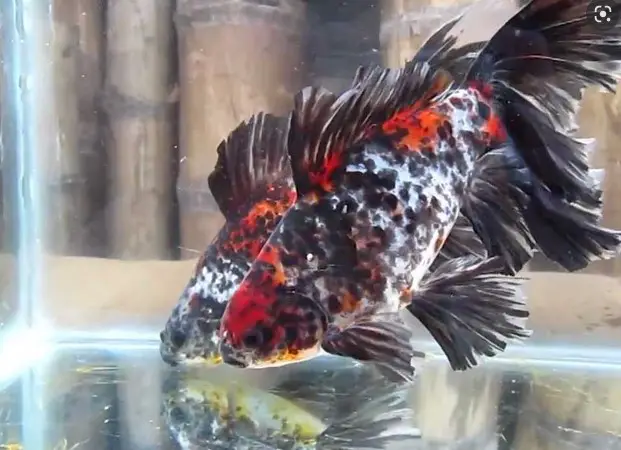
The American Shubunkin goldfish
The American Shubunkin goldfish/ calico goldfish can be distinguished by their tail. This type of calico fish has a long-pointed tail with a deeper fork.
Ranchu goldfish
This type of goldfish has an egg-shaped body with a deep belly. Also, ranchu has a more downturned tail and fin tail. Special thing is, that they do not have a dorsal fin. Ranchu has calico (nacreous) scalation.
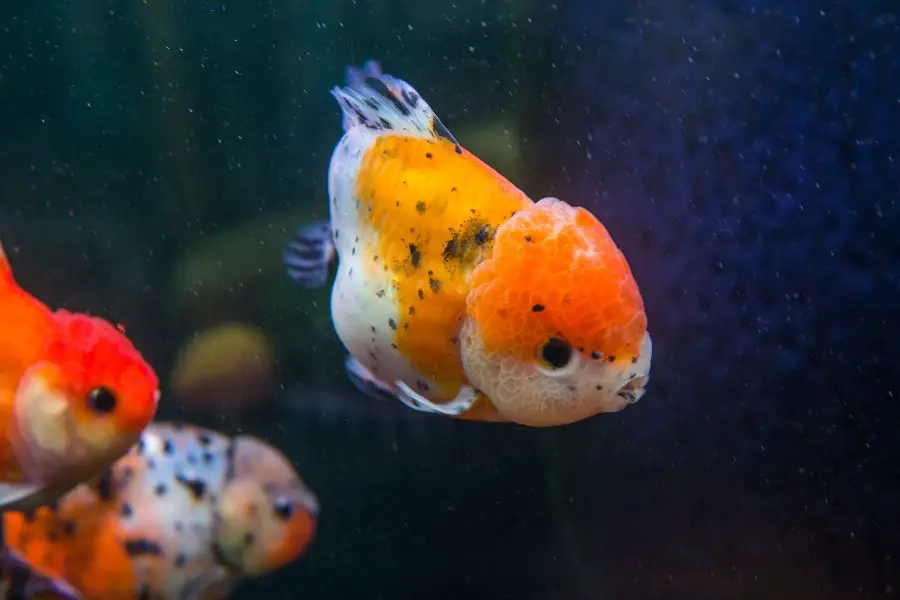
Oranda goldfish
Oranda goldfish have a “hood” like a prominent bubble on their head. this goldfish has a long, large, and deep body. these fish come in calico colors.
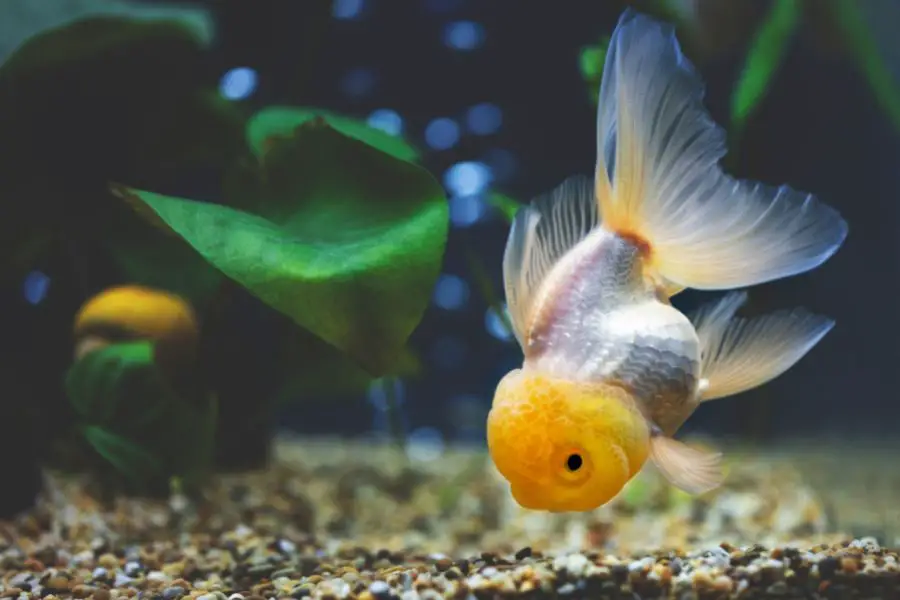
Tank preparation for your Calico Goldfish
Size of the tank
The requirements of the calico goldfish’s tank or pond highly depend on the types of goldfish. You should plan the tank size according to the goldfish variety.
Normally, you should have an aquarium of at least 20 gallons (75.8L) for the small goldfish such as telescope eyes goldfish and fantails goldfish. The main problem is the amount of wastes created by the goldfish.
It causes to increase in the ammonia level. You should highly consider the tank filter. The filter should be rated for more than twice the size of your tank to meet the demand. If you love to keep a true calico shubunkin goldfish, you should try to purchase a big tank. Fish keepers think one can live happily in a 15-gallons (56.8L) tank.
But keep in mind, if you want to keep more than one calico shubunkin goldfish and also you want to keep them happy, the recommendation is, that you should have at least 75 gallons (283.9L) tank. Because you have the ability to keep ammonia levels down by selecting a big tank.
Water quality that suitable for Calico Goldfish
Temperature
The optimal temperature level is between 67-72 Fahrenheit. Calico fish have the ability to tolerate a few degrees above freezing. Also a sudden temperature drop has the ability to kill your calico goldfish. because of that If you live in an area that varies rapidly from hot to cold, you should need to use a heater for your fish tank.
pH
The best pH level is 7.2-7.6. The sudden changes in pH level are bad for your calico goldfish. Generally, goldfish can tolerate the variations of pH level better than other fish species. However, it is better to maintain a favorable level of pH.
Hardness
The general hardness of the water describes the trace elements like Magnesium, Calcium, potassium, sodium, sulfates, and chlorides in water. Carbonate hardness is the level of carbonate and bicarbonate in the water.
The ideal carbonate hardness level is 120ppm. These are essential elements to survive and sustain in an ecosystem. The optimal general hardness level for Calico Goldfish should be in between 120ppm and 160ppm.
Other water conditions
Like other fish, goldfish regulate the sleep/ wake cycle by using aquarium light. Because of that, you should provide an appropriate aquarium light for your calico goldfish tank. Further, as the greatest substrate for your calico goldfish tank, you can choose small size rounded gravels medium. Because it allows goldfish to search and pick foods on the substrate.
Plants and Decoration in Calico Goldfish tank
If you like to keep live plants, keep in mind, that goldfish are omnivores. Thus, they eat plants. Also keep in mind you should have to eliminate the decorations that can be a danger for your fish such as sharp decorations, plastic plants, and ridged gravel.
Filter system in Calico Goldfish tank
You should have a heavy filter system. Because goldfish including calico goldfish create a lot of waste quickly. Toxic wastes can harm your goldfish. Because you should choose a better filter system to remove the wastes.
Canister filter, HOB – or hang-on back filter, Submersible filter, under gravel filter, and External filter are the filter types. When you select the filter, you should consider the capacity of the filter, brand name, materials of filter, filtration media type, size of the tank, and etc.
Aeration setup
Goldfish especially fancy goldfish need high dissolved oxygen to survive as well as to reach adulthood. Therefore, if you need happy calico goldfish, you should consider about good aeration system.
Cleaning and maintainig your Calico Goldfish tank
Daily cleaning Calico Goldfish tank
Uneaten foods cause to dirt your tank water. Therefore, after feeding you can remove these uneaten foods by using a net or siphoning method.
Weekly cleaning your Calico tank
There are three steps to follow.
- Remove about 20% of the water from the goldfish tank in every week and discard them.
- Clean the green algae that are growing in the tank.
- Treat the new water by using de-chlorination. Put a few de-chlorination drops and keep this replacement water for 15 minutes. Also during this time the water reaches a temperature that is similar to the tank water.
Read Why the Goldfish tank appears cloudy? 8 causes to fix
Should I Completely clean out the Calico Goldfish tank?
It does not recommend to clean your goldfish tank completely. But if there is an unavoidable circumstance (parasitic infection, Leech infestation, etc.), you have to clean your whole tank. If So, follow the below steps.
- Firstly, you should set up a temporary home for your goldfish. You can use the water from the tank that you are going to clean.
- Because it helps to reduce the stress of your Calico Goldfish. Use a plastic container to remove the fish. To avoid any harm or injury to your goldfish, use a net if you want.
- Remove all goldfish accessories and rinse them well. Then take a container and fill it with hot water. Put all the goldfish accessories into that container. You can keep them for the entire time that you take to clean the tank.
- It is better, do not to use any soap or cleaning products to clean your goldfish accessories. If you have live aquatic plants in your tank, dig them out and move them to one side of your tank or you can put them in a temporary tank.
- Using your algae scrubber, rub the sides and corners of your aquarium glass.
- If you have a gravel bottom, use an aquarium gravel cleaner to suck up dirty waste. If you do not have aquarium gravel cleaner you can use your hands to remove the waste.
- Clean the filter system of your tank.
- After cleaning all these things, you can fill the tank with treated water. To treat water, you can use a de-chlorinator. It helps you to eliminate chlorine.
- Keep this new water for about 15 minutes to reach a temperature that is similar to the water temperature before you clean. After that, you can put your goldfish accessories in the tank. At last, add your fish into the tank carefully.
How to feed the Calico Goldfish
Food type
Choosing the best quality foods for your Calico Goldfish is one of the important things to keep your goldfish healthy and happy. It is recommended specially formulated goldfish food.
Because these foods have a lower protein concentration and higher carbohydrate content than standard fish diets. There are goldfish foods in different forms. Also, forms are flakes and pallets. The famous goldfish foods are Tetra Fin Balanced Diet Goldfish Flake Food, Fluval Bug Bites Pellets for Goldfish, and Omega One Goldfish Small Sinking Pellets.
In addition to these goldfish foods, Calico Goldfish also eat the following foods.
- Bloodworms
- Shelled peas- skins removed
- Brine shrimp
- Leafy greens
- Ghost shrimp
- Daphnia
- Grapes
- Boiled or microwaved diced broccoli
- Crickets
- Boiled or microwaved peeled and diced zucchini
- Boiled or microwaved diced corn
- Orange slices
- Fish algae wafers
Feeding frequency
You can feed your Calico Goldfish 2-3 times daily.
direct Overfeeding
Goldfish including Calico Goldfish can be overfed easily. They always act as hungry. Goldfish are grazers in nature and always they look out for their next meal.
Also, Overfed goldfish produce excess waste. It causes to pollute the water and creates an unhealthy and unclean environment for your fish. Therefore, you can use the following signs to identify overfeeding.
- Cloudy Water
- Overfed fish is swimming Upside Down
- Bloating and Feces
- Growing algae
Read What Can Goldfish Eat? 32 Foods Goldfish Likes to Eat and Nutrition
Tank mates of Calico Goldfish
Therefore, you should keep this in mind when you choose the tank mates for this Goldfish. The best tank mates are,
- Platy Fish
- Black Skirt Tetras
- Bloodfin Tetras
- Rosy Barbs
- Gold Barbs
- Giant Danios
- Zebra Danios
- White Cloud Minnows
- Japanese Rice Fish
- River Murray Rainbow Fish
- Scissortail Rasbora
- Corydoras Catfish
- Hill Stream Loach
- Weather Loach aka Dojo Loach
Read Can I Keep Koi and Goldfish In the Same Tank? All To Know
Common Calico Goldfish diseases
ICH – White spot disease
| Symptoms | Treatments |
| Clamped fins | Raising the temperature |
| Flashing | Salting the tank |
| Lethargy | |
| Loss of appetite | Waiting 10-14 days and keep the water properly |
| White spots |
Flukes
| Symptoms | Treatments |
| Gasping at the surface | Paraziquantel and Potassium Permanganate |
| Flashing | Salting the tank |
| Frayed fins |
Anchor Worm
Anchor worm is like a piece of thread that comes under a single scale.
| Symptoms | Treatments |
| Flashing and scratching | Remove the worm by using tweezer |
| Lethargy | After cleaning the wound by using hydrogen peroxide |
| The place where the worm is attached become very red and bloody |
Fish Lice – “Flying Saucer” bugs
| Symptoms | Treatments |
| Fish lice are small disk-like green specks that you can see moving around your fish. They usually show around the chin, stomach, and fins. | Give organophosphates as 2 or 3 doses at 1-week intervals |
| Scratch and itch, leaping and darting | |
| Red wounds of the body |
Trichondia
| Symptoms | Treatments |
| Scratching and irritation | High concentration of salt |
| Itching | |
| Stop eating |
Hole-in-the-head
| Symptoms | Treatments |
| Red dot or bloody patch on the head | Perfect water condition |
| Strat to sink in deeper, pitting and spreading | Use together the antibiotics Furan 2 and Kanaplex |
Fin rot
| Symptoms | Treatments |
| Cloudiness on the fins | Perfect water condition |
| Fins get whiter at the tips | Use hydrogen peroxide swab every 24 hours or use MinnFinn |
| Begin to rot away and splitting | If case is advanced you can use antibiotics like sulfaplex |
How to breed Calico Goldfish
Calico Goldfish are egg layers and in the wild, they tend to spawn when the water warms up. Therefore, to encourage them you should maintain favorable conditions in your aquarium. To spawn, the fish should be healthy without any illnesses. Also, they need space.
Because of that, you should have at least 20 gallons in the tank. Also you should proved good surface for eggs. So you can grow live plants because a heavily planted aquarium helps to lay eggs. Further, you can use artificial, silk plants or fibrous spawning mops.
Also, change the 20% water per day can increse probabaility of breeding. Above all You can motivate fish to spawn by reducing the tank temperature to around 600 F gradually. Until the fish start mating, you can increase it slowly at a rate of 30 F per day. The favorable temperature is 68 to 74 F. Another important thing is, that you should feed your Calico Goldfish well with quality and protein-rich foods such as live food.
Difference between albino telescope fish and Calico Goldfish
Albino telescope goldfish has a special feature. It has red protruding eyes. This type of telescope eye goldfish has a deep body with long flowing fins. The Calico Goldfish or Siamese doll goldfish is a rare type of fantail goldfish. Normal it has black eyes but some types of fish have red protruding eyes. They are called Albino Siamese goldfish.
Difference between black moors fish and Calico Goldfish
Black moor goldfish is a type of fancy goldfish. Black moor fish has a black body and it is rounder than common goldfish. This fish has flowing fins and telescope eyes. Also these fish have the ability to grow up to 6-8 inches.
The Calico Goldfish or Siamese doll goldfish is a rare type of fantail goldfish. Normal Calico Goldfish have black eyes but some types of fish have red protruding eyes. They are called Albino Calico Goldfish.
Related questions
Are calico goldfish aggressive
When comparing with other fish, calico goldfish is less aggressive. Generally goldfish are peaceful and gentle-matured fish. But feeding behavior, spawning, sickness, personality, territorial, higher stocking densities, and body characteristics can be caused to the aggressive behavior of calico gold fish.
Do calico goldfish change color
Goldfish including calico goldfish change their color throughout their lifetime. Baby goldfish’s color is usually grey, brown, and dark brown. These colors help them to stay safe. When gradually they grow up, signature colors and patterns start to develop.
These colors and patterns change quickly in a month or a few days and you don’t have to worry about that. If you see darker spots between grey and blue areas of calico goldfish, it is a normal thing. It happens as a result of red, black, or yellow patches developing or fading.
Lighting, tank setting, feeding, and water quality affect the appearance of your fish. As an example, some lights cause to show completely different color appearances.
Why is my fantail goldfish turning white?
Goldfish have skin pigmentation that reacts to light. This affects their skin when they lose light or have less exposure. Then, they lose their color and turn white.
Do calico goldfish recognize their owners?
According to Oxford University scientists, goldfish have the ability to remember their owners.
Also read Black Oranda goldfish care 15 things must know
